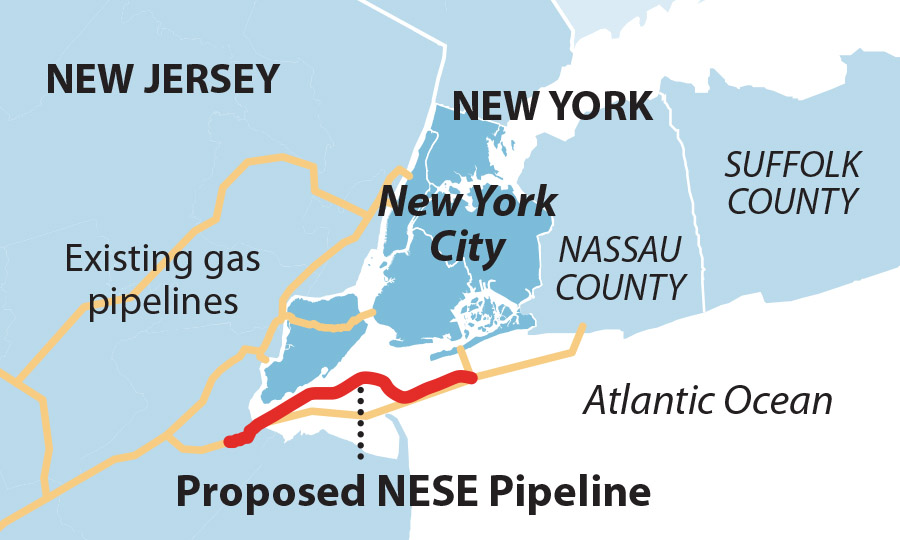IEEFA report: Proposed NESE gas pipeline may stick New York ratepayers with one billion-dollar+ cost

April 17, 2020 (IEEFA NEW YORK) ‒ National Grid’s proposed Northeast Supply Enhancement (NESE) pipeline will cost at least $1 billion to build, supplying gas for which there is no demonstrable need, according to a report submitted to regulators today by the Institute for Energy Economics and Financial Analysis (IEEFA).
The NESE pipeline would channel fracked gas from Pennsylvania to downstate New York. Under the terms of the proposal, ratepayers in Long Island, Brooklyn, Staten Island and most of Queens would have to pay $193 million a year for the next 15 years to cover the pipeline’s cost.
National Grid claims that the proposed pipeline is needed to meet growing demand for heating in cold weather, but fails to provide convincing evidence, according to the report Proposed NESE Gas Pipeline in New York: A Bad Bargain for Ratepayers and Taxpayers.
“The NESE pipeline proposal fails to take into account today’s reality of increased efficiency, technological advancements and more affordable, sustainable renewable options,” said report lead author and IEEFA policy analyst Suzanne Mattei. “This proposal is unwise and high-risk with ratepayers expected to bear the brunt of the cost.”
The pipeline would be profitable for its developer, the Williams Companies, Inc., based in Tulsa, Oklahoma, and related construction would reap benefits for National Grid, according to the IEEFA analysis. But New York ratepayers face substantial risk.
“National Grid does not disclose what will happen if construction costs are higher than predicted—a common occurrence in large construction projects like these,” said Mattei, “Also, the pipeline would likely soon become obsolete, leaving utility customers paying for an asset that provides no service.”
The pipeline project led to a tug of war between the New York State Department of Environmental Conservation (NYSDEC) and National Grid. After the proposal was initially rejected by NYSDEC, the company unilaterally declared a moratorium on providing gas to new customers in the region.
The New York State Public Service Commission (PSC) ordered National Grid to lift its unauthorized moratorium and submit a proposal that includes long-term energy need projections and alternatives to the pipeline.
The IEEFA analysts find that the pipeline is unnecessary for the following reasons:
- There is no urgent, pending, unmet demand for gas heating. Ratepayers are being asked to foot the whole bill for a pipeline that will be used mainly on the coldest winter days.
- Conditions of extreme cold weather (“peak demand”) occur only a few days per year, and Con Ed projects a 33% decrease in gas sales by 2050, a 49% decrease by 2080.
- More flexible, targeted non-pipeline methods exist to manage and reduce peak demand.
- The coronavirus pandemic is likely to have a dampening effect on demand, and other energy choices exist beyond natural gas.
- Future economic growth in New York does not depend on soaring use of natural gas.
“The question is not whether sufficient supply exists to meet current need. It does,” said Mattei. “It is more about how to meet the future demand from economic growth in the region and the data confirms that there is no need for this pipeline.”
Full report: Proposed NESE Gas Pipeline in New York: A Bad Bargain for Ratepayers and Taxpayers.
Suzanne Mattei is an IEEFA energy policy analyst.
Tom Sanzillo is IEEFA’s director of finance.
Margaret Stix is president of Lookout Hill Public Policy Associates.
Media Contact: Vivienne Heston ([email protected]) +1 (914) 439-8921
About IEEFA: The Institute for Energy Economics and Financial Analysis (IEEFA) examines issues related to energy markets, trends and policies. The Institute’s mission is to accelerate the transition to a diverse, sustainable and profitable energy economy.












